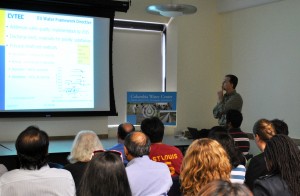
Imagine you have one quart of water to last for a couple of days. You should probably use it wisely, taking a sip here and there to stay hydrated, but instead, you dump it on the ground to wash a piece of sidewalk in front of your apartment building. Now, you have no water to drink. According to Raymond Farinato, a senior researcher and fellow at Cytec Industries (and an Aikido master to boot), a similar process often happens when mining companies use potable water for extraction operations.

“Why waste high quality groundwater for some of these operations when you only need low quality recycled water?” he asked a group of students and professors at the Columbia Water Center last Friday afternoon. “Now is a golden opportunity to do that, because the mining industry is a lot more willing to listen now that they have been in the past.”
Farinato, the Water Center’s final guest lecturer in the spring seminar series, honed in on ways to make mining and oil sand production more efficient consumers of water resources. But while he noted that reusing industrial effluent can reduce strain on an already taxed drinking water supply — particularly in the West, where water is scarce and mines plentiful — the practice also has its share of problems. Extra particles in reused water pose a number of challenges for engineers and scientists, namely decreased extraction efficiency, scaling inside pipes, faster equipment wear from corrosion, and the dangers inherent in maintaining a supply of contaminated water.
Farinato also suggested reducing the amount of energy used in water filtration and transport by opting for onsite treatment methods for industrial applications. He pointed out that often, as is commonly seen in oil sand production and hydraulic fracturing, contaminated effluent is shipped offsite in tanker trucks, adding significant cost and environmental impact to the production process.
“Surface mining [oil sand] is expensive,” said Farinato. “Pumping steam into the earth is like trying to air condition New York City by opening the door of a building. It takes a lot of energy.” But he suggested diminishing energy consumption by reusing water from tailings ponds in order to reduce truck trips to and from treatment plants. The coagulants and floculants used in onsite treatment processes have become commoditized, he said, making them cheaper and more accessible. Corrosion control chemicals are often highly toxic; another reason Farinato gave for minimizing transport. Keeping hazardous chemicals in one place would maximize safety.
“If there’s a spill and those go into the water supply, that’s a problem.”
Watch Mr. Farinato’s talk here:
–
Columbia Water Center demonstrates research-based solutions to global freshwater scarcity. Follow Columbia Water Center on Facebook and Twitter



